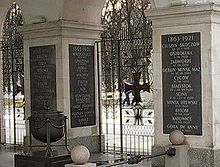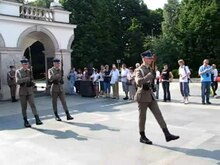Tomb of the Unknown Soldier (Warsaw)

The Tomb of the Unknown Soldier ( Polish: Grób Nieznanego Żołnierza ) is a symbolic tomb erected after the First World War to commemorate the Polish unknown soldiers who died in the fight for the freedom of Poland . The tomb is located under the arcades of the former Saxon Palace on Piłsudski Square in Warsaw .
architecture
The tomb, based on the design of the Polish sculptor Stanisław Kazimierz Ostrowski , was located below the central part of the Saxon Palace , which was then the seat of the Polish Ministry of War. The central memorial stone was surrounded by five eternal flames and four memorial stones with names and dates of battles that Polish soldiers fought during the First World War and the Polish-Soviet War . Two steel grids with symbols of the highest Polish military orders - Virtuti Militari and Krzyż Walecznych - were added behind the tomb .
history

In 1923 Warsaw residents placed a memorial stone in front of the Saxon Palace and the adjacent Saxon Garden for the unknown Polish soldiers of the First World War and the subsequent Polish-Soviet War. This initiative went back to various Warsaw newspapers and General Władysław Sikorski .
On April 4, 1925, the Polish War Ministry selected the battlefield of the Battle of Lviv from over 40 battles , from which the ashes of an unknown soldier were brought to Warsaw. In October 1925, three coffins of unknown dead were exhumed at the Łyczakowski cemetery in Lemberg: a non-commissioned officer, a corporal and a corporal. The coffin that was transported to Warsaw was chosen by Jadwiga Zarugiewiczowa, the mother of a soldier who died near Zadwórze and whose body was never found. On November 2, 1925, after a mass in the St. John's Cathedral in Warsaw, eight bearers of the Virtuti Militari order led the coffin to its final resting place, below the portico that connects the two wings of the Saxon Palace. The coffin was buried together with 14 urns containing soil from as many battlefields, a Virtuti Militari order and a deed of establishment. Since then - with an interruption during the German occupation in World War II - an honor guard has been kept in front of the tomb.
During the Polish War of Defense in 1939 , the building, which was slightly damaged by German air raids, was repaired and confiscated by the German authorities. After the Warsaw Uprising in December 1944, the Wehrmacht destroyed the palace; only the part of the central portico that protected the tomb remained.
After the war ended in 1945, reconstruction began under the direction and according to designs by Henryk Grunwald . Initially, only a small part of the palace, which contained the tomb itself, was restored and made accessible to the public again on May 8, 1946. Additional plaques for Polish battles during World War II and earth from 24 additional battlefields were added. However, the communist authorities removed all traces of the Polish-Soviet war of 1920, except for part of the battles of the Polish army in the west. After Poland regained its political autonomy in 1990, the new city administration corrected the representation.
The Tomb of the Unknown Soldier is where all major state celebrations take place these days.
Web links
Footnotes
Coordinates: 52 ° 14 ′ 27.6 ″ N , 21 ° 0 ′ 40.6 ″ E



